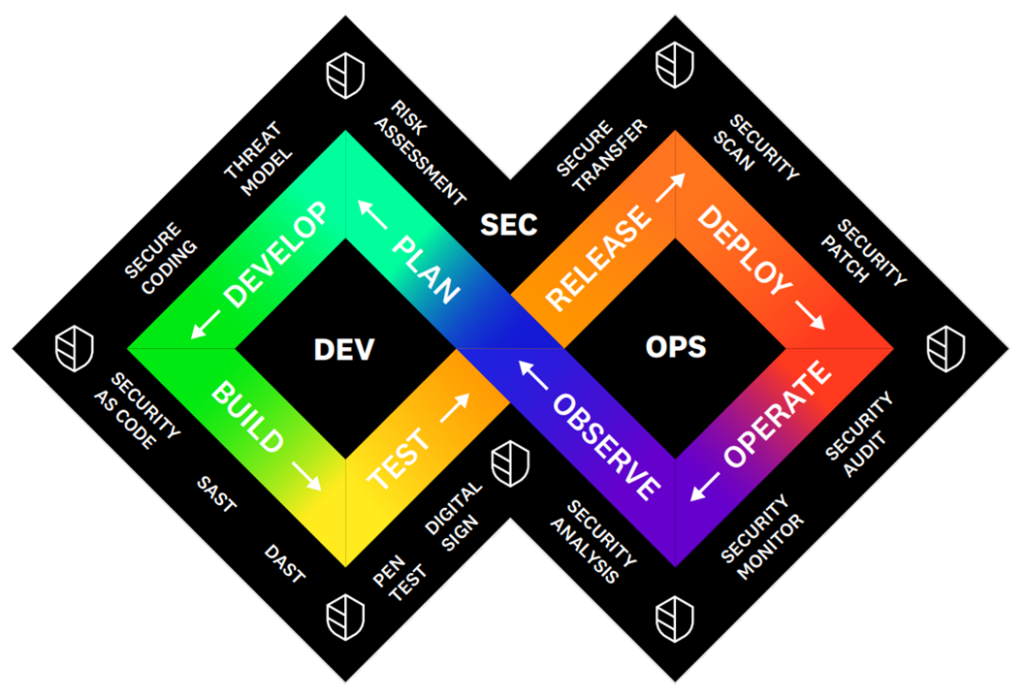For moving forward in DevSecOps, leaders must ask themselves three key questions:
- Where is my organization now?
This assesses the companies current competencies. - Where do I want my organization to be?
Define a state of “good” for the company in terms of competitive landscape. - How do we get there?
Identify initiatives for bridging the gap in-between.
For answering these questions a maturity model is recommended, which presents a prescriptive point of view on a defined domain. A common – yet easy – model might be based on stages as illustrated below:

- Beginner
This phase marks the beginning of the DevSecOps journey. Most important is a shift in culture and mindset that emphasizes sharing and collaboration across technical disciplines, and a desire to improve performance as a team. This is the foundation of DevSecOps. - Intermediate
In this stage, organizations are consistently releasing software but may experience bottlenecks, performance issues, and some team friction. While security controls are shifting earlier in the development process, much of the security-related work is still done towards the end of the process, which can slow down release cycles and result in lower quality code. - Advanced
In this stage, organizations are highly efficient and productive, releasing high quality, secure software on a regular basis to a reliable platform. Security checkpoints are embedded throughout the software development lifecycle. - Expert
These are DevSecOps practices employed by the most cutting edge organizations. These organizations release high quality code multiple times per day. Security controls are deeply embedded throughout the SDLC, and security has ceased to be a siloed domain. A key aspect of this stage of maturity is a very high level of automation of processes across Development, Operations, and Security
DevOps targeted the improvement of speed and quality of writing and running software by encouraging collaboration and shared responsibilities between Dev and Ops teams.
The increase velocity of DevOps teams opened complications, which slow down DevOps lifecycles:
- Security Issues are overlooked
as DevOps teams target functional and non-functional – in terms of performance – requirements. - Security is a bottleneck (or ignored)
as security teams are separated into a dedicated silo, having separate tools, culture and processes.

These developments suggest that security is integrated into the DevOps lifecycle more deeply. DevSecOps is literally the logical next stage of evolution, breaking silos between security and DevOps teams and realizing the full potential of the movement.
DevSecOps is the next evolution of DevOps, not a departure from it.
Competencies
DevSecOps – just like DevOps – is a philosophically defined way for collaboration and requires competencies for its fulfillment:
- People & Culture
Encompasses organizational structure, communication
styles, values, incentives, behaviors, leadership, and individual and
team health. - Plan & Develop
Encompasses how work is prioritized, how much work is planned versus unplanned, how much work is new feature development versus paying down technical debt, and how much risk assessment and code validation factors into the earliest stage of the development process. - Build & Test
Covers testing processes and automation, quality assurance, code scanning techniques, and build and signature validation. - Release & Deploy
This competency focuses on deployment strategies and release frequency, automation of the deployment process, and validation and remediation of deployment issues. - Operate
Covers infrastructure as code, capacity planning, scaling and reliability, chaos testing and red teaming, patching, and disaster recovery. - Observe & Respond
Focuses on Service Level Objectives (SLOs), vulnerability and misconfiguration scanning, security monitoring, user experience monitoring, incident management, and post-mortems
The Model
When combining stated stages and compentencies into a matrix, a maturity model is generated, guiding metrics for shifts:
| Competence | Beginner | Intermediate | Advanced | Expert |
| People & Culture | – Functional teams siloed – High inter-team friction – Nascent onboarding processes – Burnout common | – Silos breaking down – Embracing experimentation & transparency – Onboarding process exists – Burnout openly discussed | – Continuous collaboration across teams – Blameless culture – Comprehensive onboarding process – Burnout quickly addressed | – Cross-functional teams aligned to products and services – High trust, experimentation, learning culture – Burnout rare |
| Plan & Develop | – Risk and security not considered – High technical debt – Excessive bug fix work – Code not validated | – Limited risk assessment – Moderate technical debt – Moderate bug fix work – Some code validation | – Threat modeling and risk assessments – Low technical debt – Low bug fix work – All code validated | – Extensive threat modeling/risk assessment – Minimal technical debt – New feature focus – All code validated automatically |
| Build & Test | – Manual testing – No code scanning – No build/signature validation – Limited core functionality testing | – Partial test automation – Partial code scanning – Partial build/ signature validation – Partial core functionality testing | – High test automation – Dynamic code scanning – Significant build/signature validation – Significant core functionality testing | – Complete test automation – Comprehensive dynamic code scanning – Comprehensive build/signature validation – Comprehensive core functionality testing |
| Release & Deploy | – Manual deployments – Large, infrequent releases – No deployment security posture criteria – Difficult to remediate failed deployment | – Partial deployment automation – Medium-sized, monthly releases – Basic deployment security posture criteria – Acceptable failed deployment remediation times | – High deployment automation – Small, weekly releases – Detailed deployment security posture criteria – Fast failed deployment remediation times | – Full deployment automation – Numerous daily releases – Automated deployment failing – Bias to fast forward fixes |
| Operate | – Manual provisioning/ configuration – Long capacity planning cycles – Manual scaling – Single availability zone – No chaos testing or red teaming – Poor patching hygiene – No disaster recovery strategy | – Partial configuration/ provisioning automation – OpEx-based capacity planning – Partial auto-scaling – Multi-availability zone/region – Basic chaos testing or red teaming – Basic patching hygiene – Basic DR strategy | – Extensive configuration/ provisioning automation – Capacity planning based on seasonality/ growth – Significant auto-scaling – Multiple cloud providers / high availability – Significant chaos testing & red teaming – Fast patching – Comprehensive DR strategy | – All infrastructure configurations and instructions instantiated as code – Capacity planning based on granular usage trends/ predictions – Comprehensive auto-scaling – Multiple cloud providers / very high availability – Continuous chaos testing & red teaming – Patching SLA – DR plans tested often |
| Observe & Respond | – No SLOs formed – No vulnerability/ misconfiguration scanning – No security metrics defined – Siloed telemetry – User journeys unknown – Excessive MTTD and MTTR – No post-mortems | – Basic SLOs formed – Partial vulnerability/ misconfiguration scanning – Some security metrics defined & visible – Some common observability data sets – Basic understanding of user experience – Moderately high MTTD and MTTR – Basic post-mortems | – SLOs & error budgets favored – Significant vulnerability/ misconfiguration scanning – Security metrics defined & visible for most services – Common observability data platform – Detailed user journey visibility – Moderate-to-low MTTD and MTTR – Detailed post-mortem | – SLOs & error budgets drive decisions – Extensive vulnerability/ misconfiguration scanning – Security metrics defined & visible for 100% of services – Standardized metadata model – Complete user journey visibility – Very low MTTD and MTTR – Clear, blameless post-mortems |
By assessing an organizations competence-stages (e.g. a spider-web-chart) against the defined goal, required improvements become visible. These improvements can be shifted into a roadmap or project plan, including gap-stages as milestones for the defined target.
Therefore, an improvement from Clutural Beginner to Cultural Intermediate, requires a milestone for Cultural Advanced.
Example
- Target 1: Cultural Advanced by Q2/2023, driven by Fabian.
- Target 2: Cultural Intermediate by Q4/2023, driven by Teddy.
DevSecOps Value drivers
For maximizing generated value as part of maturity-shifts, matrix driver should be rated in terms of productivity, metrics, customer metrics, costs, and revenue. This rating is illustrated below:

- Faster, more agile delivery and reduced time to market
DevSecOps enables organizations to deliver applications to market faster, and confidently iterate revenue-impacting applications with more frequency to protect and grow revenue. The integration of security into DevOps workflows eliminates potential bottlenecks and accelerates organizations’ efficiency and agility. - Improved security posture and reduced risk
DevSecOps integrates security stakeholders and security practices into all phases of the software development lifecycle and the operation of services in production. Greater collaboration, trust, and transparency among Dev, Sec, Ops teams results in lower risk software. - Reduced operational and development costs
The fast feedback loops of DevSecOps practices streamline the software development life cycle and eliminate the vast mtajority of issues before they reach production environments. Incidents that do occur are resolved very quickly. - Improved customer experiences and satisfaction
By producing higher quality and more secure software, DevSecOps increases the value organizations provide to their customers. Customers also value more frequent enhancements and upgrades to their services. Finally, customer satisfaction is also boosted when organizations are able to observe systems from the end-users’ perspective and have visibility into end-to-end customer journeys.
